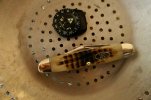Pull-throughs where the sharpening surface is a couple of ceramic rods are probably not terrible, though it does seem to me like you are moving the steel 90-degrees in the wrong direction relative to the abrasives. The ones with carbide cutters are just shredding your edge, though.
I tell you, it changed my whole experience with what is a "good" or "bad" knife, both for pocket knives and especially kitchen knives, when I put in the time to learn how to sharpen and over time assembled a set of tools for that purpose.
It took some time and intentional practice, observation, and improvement of techniques until I finally got to where it was fairly second nature.
I can now understand when someone says "Who cares if it not sharp when you get it?" What that person is saying, is that they know how to sharpen knives and don't consider it a major chore to do so. I can use expensive kitchen knives, I can use cheap kitchen knives. I can get both sharp, and have the assortment of stones for either kind.
I like my Case stainless steel knives. I have not bought a new one since maybe 2015 so I can't comment on the state of Case knives in 2024. I was used to them coming with a relatively toothy edge with a factory burr.
Most of the time they just needed a good stropping to remove the burr and lightly polish up the toothiness, but sometimes they needed some refinement. That steel actually works well with a little coarseness left. The CV steel is less prone to burr formation and likes a little more polished edge, but you can still get a mirror edge on either with a little time, decent stones, and a strop.
And then you go cut up those cardboard boxes for the recycle bin and that pretty mirror edge doesn't matter that much. That is where the slightly toothy edge works well. So I sharpen enough for whatever job I have in mind for the blade and leave it at that. If I was a whittler or carver I might find a more refined edge better suited to the work.
That stainless steel is a little prone to forming a new burr when used with ceramic stones like the Sharpmaker, though you just have to learn to use less pressure so you aren't "smooshing" the steel quite so much. It's like anything else you practice - if you pay attention and work to refine your skill, you learn the right way to do it. Nowadays I just use a 2-sided Arkansas bench stone, most of the time without oil cause I am too lazy to do the cleanup, and then I scrub the stone with bar keepers friend when it starts to get clogged up with swarf. I don't use a loupe any more to inspect the edges - I can generally tell by feel and by looking at it that I got it close enough.
I save the loupe for use with the hard steel kitchen knives and the multiple passes on progressive sets of water stones when I am really doing some serious sharpening.

Them 'taters and onions don't really notice anything but the sharpness, not whether the knife is cheap or expensive or how often I have to sharpen it.



.jpg)